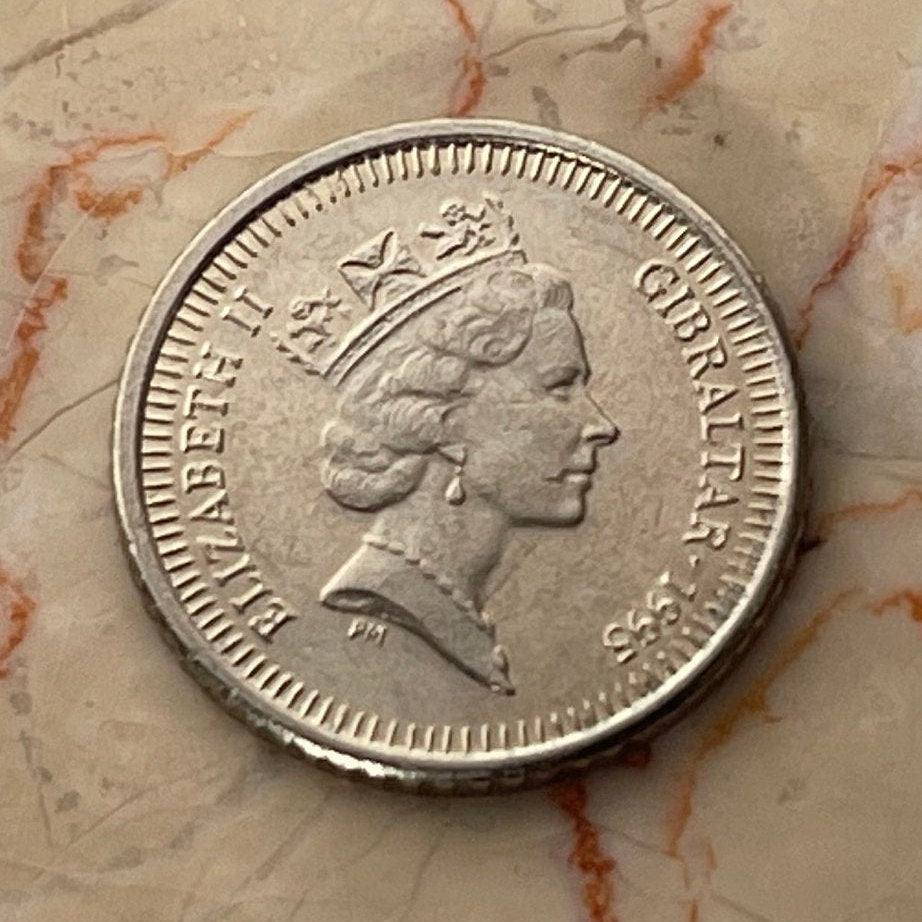elemintalshop
Barbary Macaque 5 Pence Gibraltar Authentic Coin Money for Jewelry and Craft Making
Barbary Macaque 5 Pence Gibraltar Authentic Coin Money for Jewelry and Craft Making
Couldn't load pickup availability
Barbary Macaque 5 Pence Gibraltar Authentic Coin Charm for Jewelry and Craft Making (Monkey)
Obverse
The bust of Queen Elizabeth II facing right
Reverse
Barbary macaque and Gibraltar candytuft, denomination. The famous monkey (Macaca sylvanus) originates from the African Atlas mountains and was probably brought to Gibraltar 1000 yrs ago by the moors. The candytuft (Iberis gibraltarica) is the national flower of the Rock.
Features
Issuer Gibraltar
Queen Elizabeth II (1952-date)
Type Standard circulation coin
Years 1998-2003
Value 5 Pence
0.05 GIP = 0.07 USD
Currency Pound (decimalized, 1971-date)
Composition Copper-nickel
Weight 3.25 g
Diameter 18 mm
Thickness 1.9 mm
Shape Round
Orientation Medal alignment ↑↑
Number N# 7659
References KM# 775, Schön# 640
Wikipedia:
The name Barbary refers to the Berber People of Morocco who since the beginning of history had ties with the animals surrounding their region, as the Barbary macaques. The macaque population had also been present on the Rock of Gibraltar long before Gibraltar was captured by the British in 1704 and according to records, since prior to reconquest of Gibraltar from the Muslims. It was during the Islamic period where a purported introduction may have taken place. In his work Historia de la Muy Noble y Más Leal Ciudad de Gibraltar (History of the Very Noble and Most Loyal City of Gibraltar), written between 1605 and 1610, Alonso Hernández del Portillo, the first chronicler of Gibraltar, wrote:
"But now let us speak of other and living producers which in spite of the asperity of the rock still maintain themselves in the mountain, there are monkeys, who may be called the true owners, with possession from time immemorial, always tenacious of the dominion, living for the most part on the eastern side in high and inaccessible chasms."
In his History of Gibraltar (1782), Ignacio López de Ayala, a Spanish historian like Portillo, wrote of the monkeys:
"Neither the incursions of Moor, the Spaniards nor the English, nor cannon nor bomb of either have been able to dislodge them."
Repeated introduction of animals and the lack of reliable data concerning founders of the Gibraltar macaque population has obscured their origin. The fact that all extant Gibraltarian mtDNA haplotypes were also found in North Africa, combined with the lack of fossil evidence of M. sylvanus in Gibraltar at the end of the last glaciation, greatly diminishes the possibility that the Gibraltar macaques represent or include any remnant of the original European population, a possibility which can nevertheless not be excluded. Indeed, it had been earlier suggested that the original Gibraltar macaques were a remnant of populations that had spread throughout Southern Europe[6] during the Pliocene, up to 5.5 million years ago.[7] The Macaca sylvanus species is listed as endangered by the IUCN Red List and is declining. About 75% of the total population is found in the Middle Atlas Mountains.
During the Pleistocene, this species inhabited the Mediterranean coasts and Europe, reaching as far north as Germany and the British Isles. The species decreased with the arrival of the Ice Age, to extinction in the Iberian Peninsula 30,000 years ago.
Share










Very nice coin to add to my collection.
It's a coin I'll put it in my collection
I got this and another 21 coins from this seller, and they are great! Really appreciate that they came in those small pouches; really safe keeping for the travel and storage.
Just exactly what I wanted. Seller very helpful to answer a question I had. Great purchase 👍👍
NICE COIN, WELL PACKAGED AND QUICKLY DELIVERED









